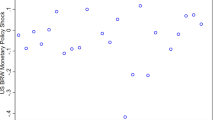Abstract
The purpose of this note is to demonstrate that the commonly held belief that incomplete and perverse pass-through are incompatible with perfect competition is wrong! To this end, we consider two types of firms both operating in two countries. The demand sides of the markets of the two countries are separated and each type of firm produces its good in one of these countries. We study the effect of an exchange-rate change on the competitive equilibrium prices in each country. When producing for the foreign market causes the same costs as producing for the home market then the “law of one price” holds and an exchange-rate change is completely offset by price changes. Furthermore, when cost functions neither exhibit economies nor diseconomies of scope between producing for the home and producing for the foreign market then prices move in the “right” directions in response to an exchange-rate change. However, with general cost structures, even in this simple perfectly competitive model, “perverse” directions of price changes can result from an exchange-rate change.
Similar content being viewed by others
References
Dornbusch, R. (1987): “Exchange Rates and Prices.”American Economic Review 77: 93–106.
Dunn, R. M. (1970): “Flexible Exchange Rates and Oligopoly Pricing: a Study of Canadian Markets.”Journal of Political Economy 78: 140–151.
Feinberg, R. M. (1986): “The Interaction of Foreign Exchange and Market Power Effects on German Domestic Prices.”Journal of Industrial Economics 35: 61–70.
— (1989): “The Effects of Foreign Exchange Movements on U.S. Domestic Prices.”Review of Economics and Statistics 71: 505–511.
— (1991): “The Choice of Exchange-Rate Index and Domestic Price Pass-Through.”Journal of Industrial Economics 39: 407–420.
Fisher, E. (1989a): “A Model of Exchange Rate Pass-Through.”Journal of International Economics 26: 119–137.
— (1989b): “Exchange Rate Pass-Through and the Relative Concentration of German and Japanese Manufacturing Industries.”Economics Letters 31: 81–85.
Froot, K. A., and Klemperer, P. D. (1989): Exchange Rate Pass-Through When Market Share Matters.”American Economic Review 79: 637–654.
Hens, T., Kirman, A., and Phlips, L. (1991): “Exchange Rates and Oligopoly.” Mimeo, European University Institute, Florence.
Kirman, A., and Phlips, L. (1993): “Exchange Rate Pass-Through and Market Structure.” Mimeo, European University Institute, Florence.
Kirman, A., and Schueller, N. (1990): “Price Leadership and Discrimination in the European Car Market.”Journal of Industrial Economics 39: 69–91.
Knetter, M. M. (1989): “Price Discrimination by U.S. and German Exporters.”American Economic Review 79: 198–210.
— (1993): “International Comparisons of Pricing-to-Market Behaviour.”American Economic Review 83: 473–486.
Krugman, P. (1987): “Pricing to Market When the Exchange Rate Changes.” InReal Financial Linkages among Open Economies, edited by S. W. Arndt and J. D. Richardson. Cambridge, MA: MIT Press.
Mann, C. L. (1986): “Prices, Profit Margins, and Exchange Rates.”Federal Reserve Bulletin, June: 366–379.
Marston, R. C. (1990): “Pricing to Market in Japanese Manufacturing.”Journal of International Economics 29: 217–236.
Sibert, A. (1992): “Exchange Rates, Market Structure, Prices and Imports.”Economic Record 68: 233–239.
Author information
Authors and Affiliations
Rights and permissions
About this article
Cite this article
Hens, T. Exchange rates and perfect competition. Zeitschr. f. Nationalökonomie 65, 151–161 (1997). https://doi.org/10.1007/BF01226932
Received:
Revised:
Issue Date:
DOI: https://doi.org/10.1007/BF01226932




